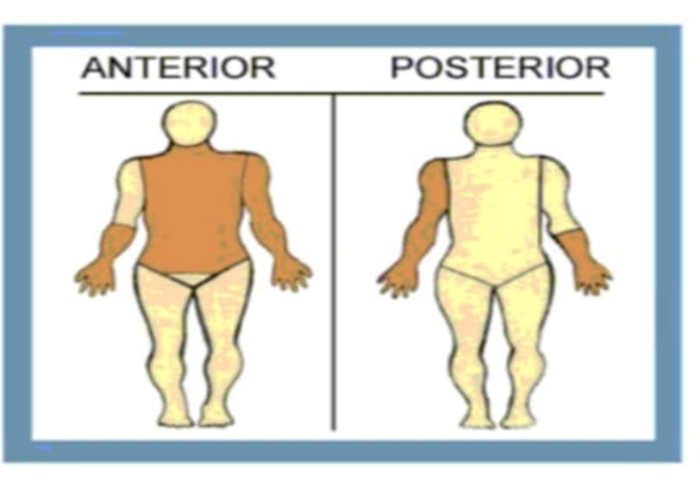A nurse in an emergency department is caring for a 118.8-lb client who sustained burn injuries in a grease fire. The nurse documents the burnt surface areas in the accompanying diagram and starts an infusion of lactated Ringers at 2300 hours. Using the Rule of Nines, what is the rate of infusion of lactated Ringers at 0600 hrs?

213 mL/hr
152 mL/hr
425 mL/hr
284 mL/hr
The Correct Answer is C
- Calculation of the TBSA according to the rule of 9s:
Anterior Trunk: 18%
Right Arm: 9% (full arm on both posterior and anterior aspects)
Left Arm: 4.5% (only one half, from the elbow to the fingers in both anterior and posterior sides).
Then TBSA = 18 + 9 + 4.5
= 31.5%.
- Calculate the rate of infusion of lactated Ringer's, using the Parkland formula:
Parkland Formula:
Total fluid volume (mL) = 4 mL × client weight (kg) × % TBSA burned
Given:
- Client weight = 118.8 lb
- Burnt surface area = 31.5%
- Infusion starts at 2300 hours (11 PM)
- We need to find the rate at 0600 hours (6 AM)
Calculation:
- Convert client's weight from pounds (lb) to kilograms (kg):
Weight in kg = 118.8 lb / 2.2 lb/kg
= 54 kg
- Calculate the total fluid volume needed for the first 24 hours:
Total fluid volume (mL) = 4 mL × client weight (kg) × % TBSA burned
= 4 mL × 54 kg × 31.5%
= 4 × 54 × 31.5
= 6804 mL
- Determine the amount of fluid to be administered in the first 8 hours:
According to the Parkland formula, half of the total fluid volume is administered in the first 8 hours from the time of the burn injury. The problem states the burn occurred, and the nurse starts the infusion at 2300. This implies 2300 is the "time of the burn"
Fluid for first 8 hours = 6804 mL / 2
= 3402 mL
- Calculate the time elapsed since the start of the infusion until 0600 hrs:
From 2300 (11 PM) to 0600 (6 AM) = 7 hours
This means 0600 is within the first 8 hours of resuscitation.
- Calculate the infusion rate for the first 8 hours.
Rate for first 8 hours (mL/hr) = Fluid for first 8 hours / 8 hours
= 3402 mL / 8 hours
= 425.25 mL/hr
- Round the answer to the nearest whole number.
= 425 mL/hr.
Nursing Test Bank
Naxlex Comprehensive Predictor Exams
Related Questions
Correct Answer is A
Explanation
A. Inspect the mouth for signs of inhalation injuries: The priority action for a client with burns, especially facial burns is to assess for potential inhalation injuries. Inhalation of hot gases or smoke can cause damage to the airways, leading to swelling, obstruction, and respiratory distress.
B. Administer intravenous pain medication: Pain management is important, but it is not the immediate priority. Ensuring the client’s airway is protected and that there are no life-threatening respiratory complications takes precedence over pain relief in the early stages of burn care.
C. Insert an indwelling urinary catheter: Inserting a urinary catheter is typically done for monitoring urine output in burn patients, especially if there is concern for fluid resuscitation needs. However, it is not the priority. Assessing for respiratory injury should come first.
D. Draw blood for a complete blood cell (CBC) count: While a CBC can provide useful information, such as signs of infection or anemia, it is not the priority action. The immediate priority is ensuring the airway is safe and free of inhalation injury, as respiratory compromise can lead to rapid deterioration.
Correct Answer is D
Explanation
A. Blockage of the ET tube by the client's tongue: If the ET tube is blocked by the tongue, the nurse would expect difficulty breathing or noisy respirations, not asymmetric chest wall expansion. This issue would typically affect both sides of the chest, not just one side.
B. Infection of the vocal cords: Infection of the vocal cords can lead to hoarseness or difficulty with speech but would not cause asymmetric chest wall expansion. The physical sign of unequal chest expansion is more related to airway placement or obstruction.
C. Passage of the ET tube into the esophagus: If the ET tube were in the esophagus, it would obstruct airflow entirely, leading to no chest expansion on either side and no air exchange. The observed asymmetry suggests partial blockage or malposition of the ET tube.
D. Movement of the ET tube into the right main bronchus: If the ET tube has moved into the right main bronchus, it would primarily ventilate the right lung, leading to absent expansion on the left side. This occurs because the tube is no longer in the trachea but in a more lateral position, ventilating only the right lung.
Whether you are a student looking to ace your exams or a practicing nurse seeking to enhance your expertise , our nursing education contents will empower you with the confidence and competence to make a difference in the lives of patients and become a respected leader in the healthcare field.
Visit Naxlex, invest in your future and unlock endless possibilities with our unparalleled nursing education contents today
Report Wrong Answer on the Current Question
Do you disagree with the answer? If yes, what is your expected answer? Explain.
Kindly be descriptive with the issue you are facing.
